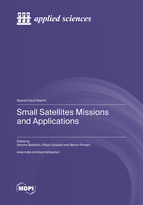Small Satellites Missions and Applications
A special issue of Applied Sciences (ISSN 2076-3417). This special issue belongs to the section "Aerospace Science and Engineering".
Deadline for manuscript submissions: closed (29 April 2023) | Viewed by 38636
Special Issue Editors
Interests: navigation and control (GNC); GNC systems; satellite missions; aerospace platforms and vehicles
Interests: orbit determination and control system; applied astrodynamics
Interests: astrodynamics and aerospace trajectory optimization; aerospace mission analysis and design; analytical and numerical methods for trajectory optimization; guidance and control of aerospace vehicles; dynamic game theory applied to aerospace trajectories
Special Issues, Collections and Topics in MDPI journals
Special Issue Information
Dear Colleagues,
In the last 20 years, two factors have revolutionized the way space missions and applications are conceived, namely an increased access to space guaranteed by new launch providers and advances in miniaturized technologies. These two factors have rapidly made small satellites a reliable tool for scientific, commercial, and educational activities in space. Acting as a part of a larger mission along with larger satellites, or even substituting the latter in some cases, small satellites have now become a reality in modern space missions.
This Special Issue on Small Satellite Missions and Applications aims to publish original research papers in this area. The following list represents some of the most relevant topics addressed by this Special Issue:
- CubeSats, PocketQubes, and other form factors;
- Scientific missions and instruments;
- Biological missions and instruments;
- Remote sensing missions and instruments;
- Interplanetary missions;
- Communication missions and payloads;
- Educational missions;
- Enabling technologies;
- Formation flying and constellations;
- Distributed architectures;
- Launch solutions and opportunities;
- Testing and verification;
- In-orbit experiences;
- Structure, materials, and manufacturing;
- Attitude determination and control systems;
- Electrical power systems;
- Software and on-board data handling;
- Propulsion systems;
- TT&C systems;
- Thermal control systems;
- Near-space platforms.
Submissions are encouraged from scholars, students, and professionals of the small satellites area.
Dr. Simone Battistini
Dr. Filippo Graziani
Dr. Mauro Pontani
Guest Editors
Manuscript Submission Information
Manuscripts should be submitted online at www.mdpi.com by registering and logging in to this website. Once you are registered, click here to go to the submission form. Manuscripts can be submitted until the deadline. All submissions that pass pre-check are peer-reviewed. Accepted papers will be published continuously in the journal (as soon as accepted) and will be listed together on the special issue website. Research articles, review articles as well as short communications are invited. For planned papers, a title and short abstract (about 100 words) can be sent to the Editorial Office for announcement on this website.
Submitted manuscripts should not have been published previously, nor be under consideration for publication elsewhere (except conference proceedings papers). All manuscripts are thoroughly refereed through a single-blind peer-review process. A guide for authors and other relevant information for submission of manuscripts is available on the Instructions for Authors page. Applied Sciences is an international peer-reviewed open access semimonthly journal published by MDPI.
Please visit the Instructions for Authors page before submitting a manuscript. The Article Processing Charge (APC) for publication in this open access journal is 2400 CHF (Swiss Francs). Submitted papers should be well formatted and use good English. Authors may use MDPI's English editing service prior to publication or during author revisions.
Keywords
- small satellites
- CubeSats
- PocketQubes
- space missions
- satellites subsystems
- mission architectures







